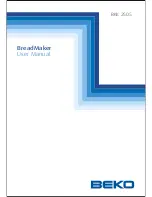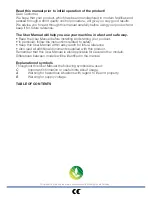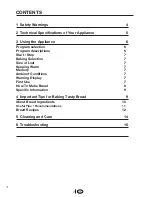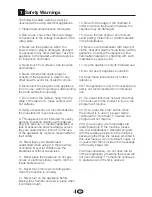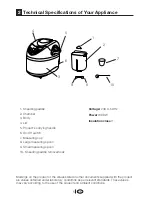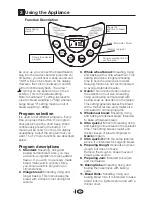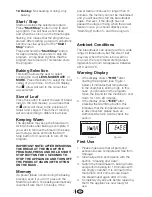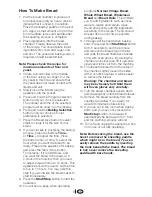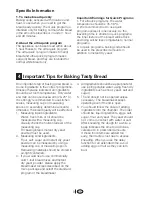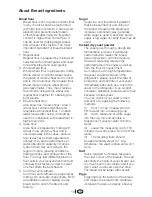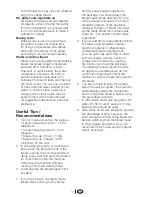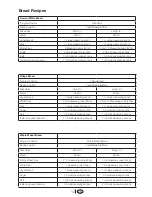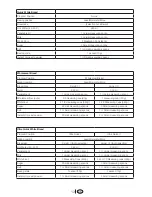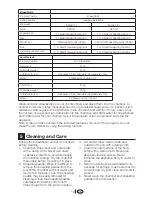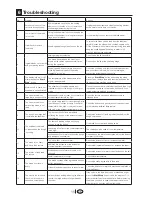
EN
10
About Bread Ingredients
Bread flour
Bread flour is rich in gluten content (that
is why it is also known as gluten flour
with high level of protein), it has a good
elasticity and prevents deformation
of the bread after rising. As its gluten
content is higher than normal flour, it
can be used for making larger bread
and a thicker inner texture. The most
important ingredient of bread is bread
flour.
1. Regular flour:
Regular flour is prepared by mixing well
selected soft and hard grains and used
for baking bread and cake quickly.
2. Whole wheat flour:
Whole wheat flour is prepared by milling
whole wheat, it contains wheat husks;
the gluten of whole wheat flour is richer
and is more nutritious than regular flour.
Bread made of whole wheat flour is
generally smaller. Thus, many recipes
recommend using whole wheat and
regular flour together for obtaining the
best results.
3. Brown wheat flour:
Also known as "Coarse flour", brown
wheat flour contains high fiber and
resembles wholemeal flour. To obtain
larger loaves after rising, it should be
used in combination with bread flour in
high proportions.
4. Cake flour:
Cake flour is prepared by milling soft
wheat or low-protein wheat and is
used especially in the cakes. Various
flour types have similar appearance;
actually, the yeast's performance or
water absorption capacity of various
types of flour vary according to the
region of origin, growing conditions,
milling process, and storage life of the
flour. You may test different brands of
flour sold in your local environment and
compare their tastes in order to select
one that offers the best flavour.
5. Corn flour and oatmeal:
Corn flour and oatmeal are prepared by
milling corn and oats, respectively. Both
are additives used for baking coarse
bread and to enrich the flavour and
texture.
Sugar
Sugar is a very important ingredient
that increases flavour and colour of
the bread. It leavens the bread and
increases nutritional value; generally
white sugar is used. Optionally, brown
sugar, icing sugar or candy floss may be
used.
Instant dry yeast powder
The yeast goes through a dough-like
fermentation process; it generates
carbon dioxide, makes the bread
rise and provide a soft inner texture.
However, leavening requires the
carbohydrates in the sugar as well as
from the flour for nourishment.
As it will go bad in high temperatures,
the yeast should be stored in the
refrigerator; please check the date of
production and shelf life of your yeast.
Immediately after each use, return the
yeast to the refrigerator in an air-tight
container. Generally, bread does not rise
because of stale yeast.
You can check if your yeast is fresh
and active by applying the following
methods.
(1) Pour 1/2 cup of lukewarm (45-
50°C) water into a measuring cup.
(2) Add 1 teaspoon of white sugar
into the cup, mix and sprinkle 2
teaspoons of yeast powder onto the
water.
(3) Leave the measuring cup for 10
minutes in a warm place. Do not stir the
water.
(4) The resulting foam should
be approximately equal to 1 cup.
Otherwise, the yeast is stale and won't
work.
Salt
Salt is required to increase taste and
the crust colour of the breads. The salt
also limits the rising of yeast. Never use
too much salt in your recipe; and if you
don't want to use salt, skip this step.
The bread will be larger without salt.
Eggs
Eggs improve the texture of the bread,
and makes the bread more nutritious,
increases the size, and gives a flavour
Содержание BKK 2505
Страница 1: ...BKK 2505 BreadMaker User Manual ...
Страница 16: ...www beko com ...

